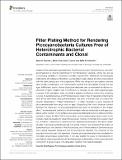Filter Plating Method for Rendering Picocyanobacteria Cultures Free of Heterotrophic Bacterial Contaminants and Clonal
Author(s)
Kearney, Sean M.; Coe, Allison; Castro, Kurt G.; Chisholm, Sallie W.
Downloadfmicb-13-821803.pdf (1006.Kb)
Publisher with Creative Commons License
Publisher with Creative Commons License
Creative Commons Attribution
Terms of use
Metadata
Show full item recordAbstract
Isolates of the marine picocyanobacteria, Prochlorococcus and Synechococcus, are often accompanied by diverse heterotrophic “contaminating” bacteria, which can act as confounding variables in otherwise controlled experiments. Traditional microbiological methods for eliminating contaminants, such as direct streak-plating, are often unsuccessful with this particular group of microorganisms. While they will grow in pour plates, colonies often remain contaminated with heterotrophic bacteria that can migrate through the soft agar. Additionally, axenic clones of picocyanobacteria can be recovered via dilution-to-extinction in liquid medium, but the efficiency of recovery is low, often requiring large numbers of 96-well plates. Here, we detail a simple and effective protocol for rendering cultures of Synechococcus and Prochlorococcus strains free of bacterial contaminants while at the same time yielding clonal isolates. We build on the fact that co-culture with specific heterotrophs—“helper heterotrophs”—is often necessary to grow colonies of picocyanobacteria from single cells in agar. Suspecting that direct physical contact between the helper and the picocyanobacterial cells was not necessary for the “helper effect,” we developed a protocol in which the helper cells are embedded in soft agar pour plates, a filter overlaid on the surface, and a picocyanobacterial culture is diluted and then spotted on top of the filter. With this approach, motile contaminants cannot swim to the colonies, and it is possible to obtain the expected number of colonies from a given input (i.e., a Poisson distribution of colonies with an expected value equal to the input number of cells), thus ensuring clonal colonies. Using this protocol, we rendered three strains of Synechococcus, two strains of Prochlorococcus, and 19 new strains of Synechococcus from coastal seawater clonal and free of heterotrophic bacteria. The simplicity of this approach should expand the repertoire of axenic picocyanobacterial strains available for controlled physiological experiments. It will also enable the study of microdiversity in populations of picocyanobacteria by facilitating large-scale isolation of picocyanobacterial clones from a single source, including direct isolation from natural seawater.
Date issued
2022-02-16Department
Massachusetts Institute of Technology. Department of Civil and Environmental EngineeringJournal
Frontiers in Microbiology
Publisher
Frontiers Media SA
Citation
Kearney, Sean M., Coe, Allison, Castro, Kurt G. and Chisholm, Sallie W. 2022. "Filter Plating Method for Rendering Picocyanobacteria Cultures Free of Heterotrophic Bacterial Contaminants and Clonal." Frontiers in Microbiology, 13.
Version: Final published version
ISSN
1664-302X